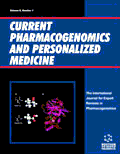-
oa Genomic Medicine: Perspective of the Challenges for the Implementation of Preventive, Predictive, and Personalized Medicine in Latin America
- Source: Current Pharmacogenomics and Personalized Medicine (Formerly Current Pharmacogenomics), Volume 21, Issue 2, Aug 2024, p. 51 - 57
-
- 08 Feb 2024
- 22 Jul 2024
- 01 Aug 2024
- Previous Article
- Table of Contents
- Next Article
Abstract
Genomic information plays an essential role in personalized medicine, with the main objective of determining risk and predisposition to disease, as well as guiding diagnosis, selection, and prioritization of therapeutic options, and even predicting prognosis. Research in the second half of the 20th century allowed genomics to move from the laboratory to clinical practice. The Human Genome Project showed the structure of the genome, the genes, and several of their regulatory pathways, which allowed obtaining exact knowledge about the molecular origin of a growing number of diseases and the development of next-generation sequencing technologies. In the second decade of the 21st century, the decrease in testing costs has allowed genomic medicine to begin to be applied in hospital institutions and outpatient services with a positive impact on public health. However, it has been evidenced that these potential benefits have not been experienced equitably throughout the world. This commentary explores the main challenges and obstacles to the implementation of genomic medicine services in order to expand their use as part of clinical practice in the Latin American context. Finally, six main barriers have been identified: i) high costs and poor access, ii) lack of trained personnel in the genomic field, iii) negative personal and social beliefs, iv) lack of representation of Latin American populations in genomic databases, v) scarce evidence of impact on clinical practice, and vi) lack of understanding of genomic test results by patients and clinicians.


